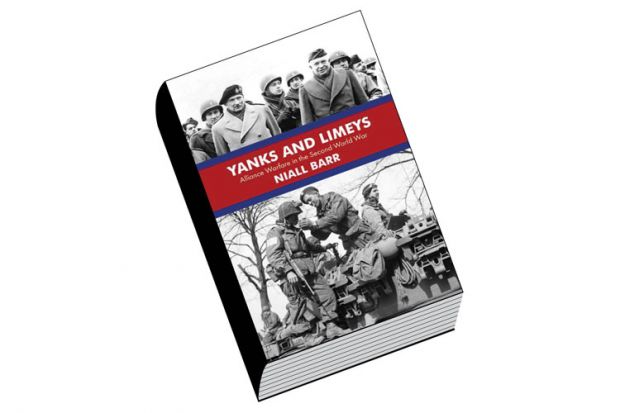From 1941 to 1945, Britain and the US were united in the common goal of defeating Germany and Japan, but they otherwise had very different interests and ambitions. The result was the combination of cooperation and conflict over military priorities and strategies that Niall Barr explores in this study of the military operations of the two allied armies in North Africa and Western Europe.
Barr sees the way the armies worked together as “the most complete unification of military effort ever achieved by two Allied nations” – although it was rather more than two, in fact, as Commonwealth and Polish troops served under British operational command. While not glossing over the tensions and differences, he regrets that they have been allowed to overshadow the achievements, and his heroes are those who strove to maintain and maximise military cooperation despite divisive pressures. Weight is lent to Barr’s argument by the fact that, despite the difficulties, military cooperation never broke down completely, and ultimately resulted in victory. However, the evidence contained in so many of his chapters is testament to the volatile relationships between Allied generals.
The men who get his praise for working for harmony and cohesion are primarily the generals George Marshall and Dwight D. Eisenhower, along with an important figure who is now almost lost in popular memory, Field Marshal Sir John Dill, the representative of the British chiefs of staff in Washington DC. This trio were, in Barr’s view, the key figures who concentrated upon the pursuit of victory and worked to maintain military cohesion. Barr reserves his criticisms for commanders who put their desire for personal reputation above the campaigns and who pursued national interests rather than concentrating on the defeat of the enemy.
Generals are, however, competitive by nature, with a tendency to lock horns, and this study makes it clear that not all quarrels between rival commanders were divided along American and British lines; generals of the same nationality fell out, and admirals and air commanders were often at variance with their army counterparts. Nevertheless, the most significant differences were between British and US generals, most famously those between Eisenhower and Bernard Montgomery. Barr generally takes the US side in such disputes, although he acknowledges that many differences stemmed from the degree to which the powers had different agendas. Whether he is correct in arguing that such differences should always have been subordinated to winning the war as speedily as possible is debatable.
Once committed to a war, any state will see victory as its essential, but rarely its only, aim, and few allies in the history of warfare have had identical interests. It was far easier for the US and its high command to concentrate upon defeating its enemies without giving much thought to the shape of the post-war world, because they were sanguine that it could be shaped to their satisfaction. The British, conscious of declining power, were determined to safeguard the Empire and the UK’s spheres of influence, and were rather more suspicious of that other ally, the Soviet Union, which is largely offstage in this study.
The nations’ commitment to defeating the Axis powers endured until victory was accomplished, as this fascinating and detailed book shows, but differences over the shape of the post-war world remained unresolved, and the US’ disregard of the UK’s interests after 1945 showed that the strategic concerns of the British generals had been justified. As Barr notes, that inveterate Anglophobe, the US general Albert Coady Wedemeyer, would come to regret this, and in 1947 wrote: “We failed to relate or to integrate the military factor in strategy with political and economic considerations.”
A. W. Purdue is visiting professor in history, University of Northumbria, and author, most recently, of The First World War (2014).
Yanks and Limeys: Alliance Warfare in the Second World War
By Niall Barr
Jonathan Cape, 560pp, £25.00
ISBN 9780224079228
Published 2 July 2015
Register to continue
Why register?
- Registration is free and only takes a moment
- Once registered, you can read 3 articles a month
- Sign up for our newsletter
Subscribe
Or subscribe for unlimited access to:
- Unlimited access to news, views, insights & reviews
- Digital editions
- Digital access to THE’s university and college rankings analysis
Already registered or a current subscriber?
